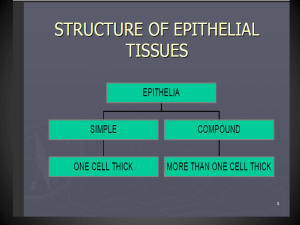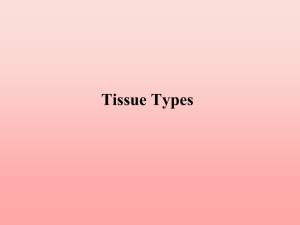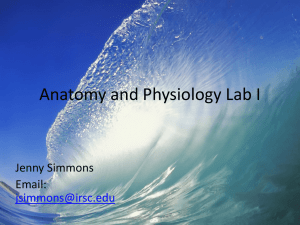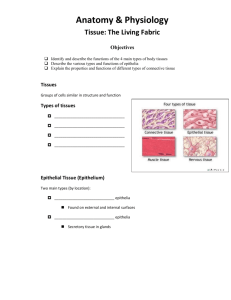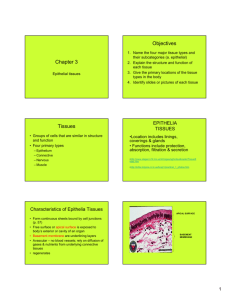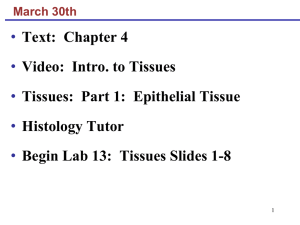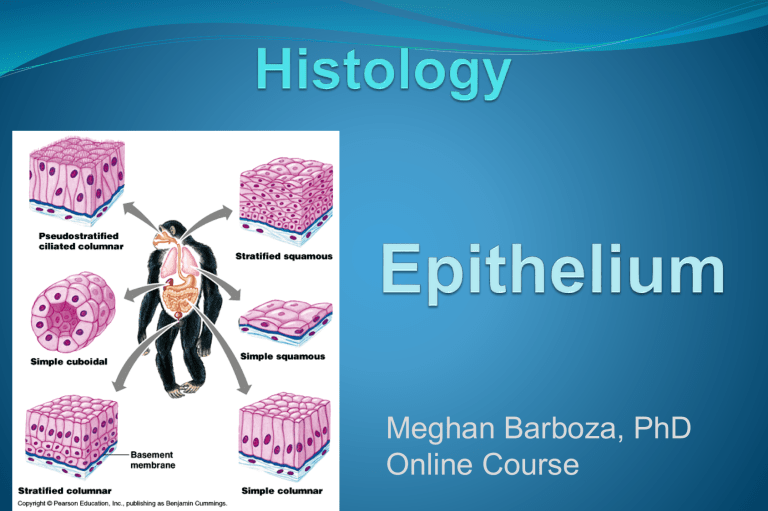
Meghan Barboza, PhD Online Course The Big Four Tissues Epithelium Connective Tissue Muscle Nerve Use key characteristics as a way to “label” cells and tissues Key Tissue Characteristics (of tissue) Include: Amount of cellularity Prevalent shape of cells and their specific functions Patterns of organization, both cellularly and extracellularly Presence or absence of specific structures such as blood vessels and nerve bundles Main Characteristics of Epithelia Very cellular tissue (little intercellular space) Not vascularized Innervated Associated with a free or luminal space theleo- tissue grows epi- upon another Functions of Epithelia Protection Functions of Epithelia Protection Absorption Functions of Epithelia Protection Absorption Secretion Functions of Epithelia Protection Absorption Secretion Selective permeability Functions of Epithelia Protection Absorption Secretion Selective permeability Surface transport of substances Functions of Epithelia Protection Absorption Secretion Selective permeability Surface transport of substances Sensory reception Basement Membrane Acellular attachment between epithelia and connective tissue Made up of basal lamina and lamina reticularis (secreted by connective tissue cells) Visible with light microscopy (PAS stains) PAS 400X of glomerulus Epithelial Classification Based on cell shape Classification Based on cell shape and layers Shape of outermost layer in multilayered types Simple Squamous Epithelium: Principal Locations • Vasculature of all types • internal lining (Endothelium) • Areas for gas exchange • lining of air sacs • Serosal lining of coelomic spaces (Mesothelium) Simple Squamous Epithelium Simple Squamous Epithelium Associated with minimal friction Simple Cuboidal: Principal Characteristics Height, depth and width comparable lengths Nuclei are round, often centrally placed Some organizational pattern of organelles Functions include: absorption, secretion and formation of small conduits (ducts) Simple Cuboidal: Principal Locations Secretory lining of certain glands that form follicles (ex. thyroid) Simple Cuboidal: Principal Locations Secretory lining of certain glands that form follicles (ex. thyroid) Areas for molecular exchange (absorption/secretion/excretion) renal tubules (kidneys), choroid plexus (brain) Simple Cuboidal: Principal Locations Secretory lining of certain glands that form follicles (ex. thyroid) Areas for molecular exchange (absorption/secretion/excretion) renal tubules, choroid plexus Conduits (ducts) for exocrine glands Simple columnar: Principal Characteristics Height of cells far exceed depth and width Nuclei can vary from round to oval, often basally placed Great organizational pattern of organelles Functions include: absorption, secretion Simple columnar: Principal Locations Mucosal lining of most of the GI tract Principal Locations Mucosal lining of most of the GI tract Lining of portion of female reproductive tract (uterine tube) 400X Pseudostratified Columnar Epithelium All cells contribute to (and contact) a basement membrane (bm) Some cells (basal) do not reach free or luminal end Cell Types: Basal cells Fusiform cells Columnar cells Principal Locations Mucosal lining of most of the respiratory tract Lining of portion of the male reproductive tract (epididymis) Stratified Squamous Epithelium “Non-Keratinized” Stratified Squamous Epithelium Keratinized Distinct morphological regions: Stratum corneum Stratum granulosum Stratum spinosum Stratum basale Principal Characteristics: Stratified Cuboidal and Columnar Epithelia Typically two-layered, sometimes greater Apical layer either cuboidal or columnar Extra layer(s) provide additional physical strength Stratified Cuboidal and Columnar Epithelia Line large ducts Stratified Cuboidal and Columnar Epithelia Line large ducts Stratified Cuboidal and Columnar Epithelia Line large ducts Line regions of GI tract and upper respiratory tract extending from strat. squamous to pseudostratified columnar epithelia: recto-anal junction Recto-anal junction Stratified Cuboidal and Columnar Epithelia Line large ducts Line regions of GI tract and upper respiratory tract extending from strat. squamous to pseudostratied columnar epithelia: Larynx Larynx Principal Characteristics: Transitional Epithelia Multilayered with the ability to change shape Change directly related to luminal changes of volume Associated with urinary tract (urothelium) relaxed Bi-nucleated apical cells stretched Check your understanding Why are epithelia that are multi-layered not useful for absorption/secretion? Why are single-layered epithelium important for transport but not protection from abrasion? Epithelia do not have vasculature, how do they get oxygen, glucose, etc…? What differentiates the location of keratinized vs non-keratinized epithelium?
